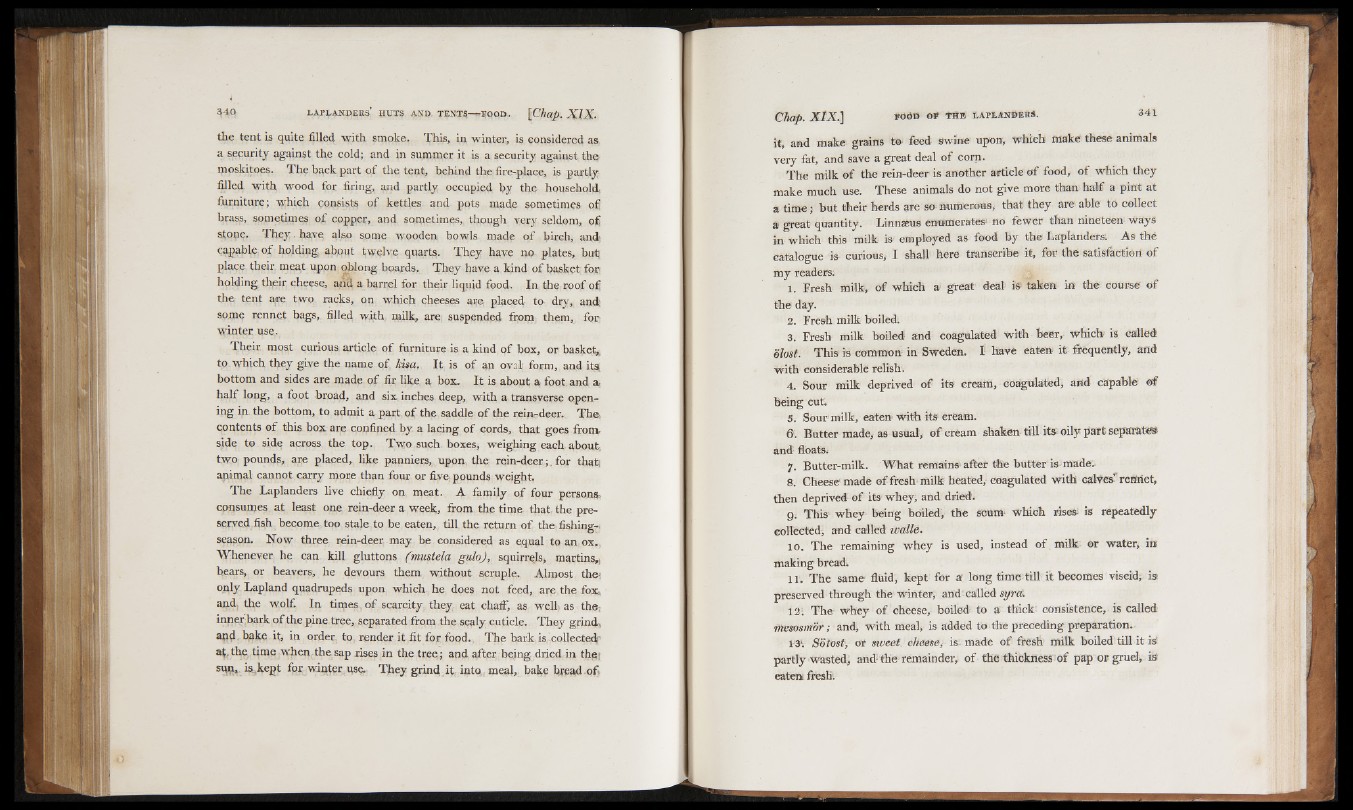
the tent is quite filled with smoke. This, in, winter, is considered as
a security against the cold; and in summer it is a security against the
rnoskitoes. The back part of the tent, behind the fire-place, is partly
filled, with wood for firing, and partly occupied by the household
furniture; which consists o f kettles and pots made sometimes ofi
brass, sometimes of copper, and sometimes, though very seldom, of
stope. T h e y . have also some wooden, bowls made of birch, and*
capable of holding, about twelve quarts. They have no plates, but
place their meat u,pon oblong boards, They have a kind o f basket for
holding their cheese, and a barrel for their liquid food. In the, roof o f
the tent are two racks, on which cheeses are placed to dry,, and*
some rennet bags, filled with milk, are; suspended from them, for
winter use.
Their mpst curious; article of furniture is a kind of box, or basket»
to. which they give the name o f Msa. I t is of an oyaf form, and its
bottom and sides are made o f fir like, a box. It is about a foot, and a
half long, a foot broad, and six inches deep, with a transverse opening
ip. the bottom, to admit a part, of the saddle o f the rein-deer. The,
Contents o f this box arp confined by a lacing o f cords, that goes from-
s|de to side across the top. Two such boxes, weighing each about,
two pounds, atie placed, like panniers, upon, the rein-deer,;, for that)
apimal cannot carry m°re than four or five pounds weight,
The Laplanders live chiefly on meat. A family o f four persons,
consumes at least one rein-deer a week, from the time that the preserved.
fish become too stale to be eaten, till the return o f the fishing-,
season. Now three rein-deer, may be considered as equal to an ox,.
Whenever he can kill gluttons (mustela guloj, squirrels; martins,t
hears, or beavers, he devours them without scruple. Almost the;
only Lapland quadrupeds upon which he does not feed, are,the fox,
and, the wolf. In tinies, o f scarcity, they, eat chaff, as well, as the,
inner,bark of the pine tree, separated from the scaly cuticle. They grind,
afld,hake it; in order, to, render it.fit for food., The bark is collectedr
a^, the, time whenfthe sap rises in the tree; and after being dried in the;
SRR*.. wu$£C;dS£. They grind it, into,, meal, bake hread.oft
it, and make grains to feed swine upon, which make these animals
very fat, and save a great deal of corn.
The milk of the rein-deer is another article of food, of which they
make much use. These animals do not give more than half a pint at
a time ; but their herds are so numerous, that they are able to collect
a great quantity. Linnaeus enumerates1 no fewer than nineteen ways
in which this milk is* employed as food by the Laplanders; As thé
catalogue is curious# I shall here transcribe it, for the satisfaction of
my readers.
1. Fresh milk, o f wbieh a* great deal to taken h» the course of
the day.
2. Fresh milk boiled;
3. Fresh milk boiled and coagulated with beer, which is called
ÿlost. This is common in Sweden. I have eaten i t frequently, and
with considerable relish.
4. Sour milk deprived o f its1 ereahi, coagulated, and capable of
Being cut*
5. Sour* milk, eaten* with its* cream.
6(. Butter made, as usual, o f cream shaken-tilt its oily part separates
and floats.1
7. Butter-milk. What remains'after the butter is made.-
8. Cheese* made of fresh milk heated, coagulated with calves' retfriet,
then deprived of its whey; and dried.
g. This* whey being boiled; the sfeuni* Which rises; is repeatedly
collected-, and called walls.
10. The remaining whey is used, instead of milk'- or water, inf
making bread,
11. The same fluid, kept for a long timed® it becomes viscid; is
preserved through the winter, andcalled syrd.
12; The w-hey of cheese, boiled to a thick consistence, is called
iitesosmor; and, with meal, is added to the preceding preparation.
SStost*, or sweet ekeeiSj is* made o f fresh milk boiled till it to
partly wasted, and* the remainder,-of the thickness o f pap or gruel; to
eaten fresh*.